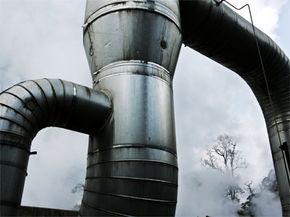You can make electricity from heat in the Earth, just ask residents of Northern California. Their electricity comes from natural geothermal energy, or hydrothermal energy, and here's how it works. It starts with water 6,562 to 13,123 feet (2 to 4 kilometers) underground, trapped in holes or cracks in rocks. The water and rock get heated by Earth's hot mantle or by radioactive minerals in the rock. Energy companies drill wells into the rock and pump up hot water or steam. The steam drives turbines in generators, which send electricity to residents' houses.
Since nature provided the hot rock, the connected holes or cracks and the water, it's considered natural geothermal energy. By contrast, enhanced or engineered geothermal systems (EGSs) don't wait for the full setup. They start with hot rock and add the water or the cracks and connections or all of it. So, all geothermal electricity comes from hot water inside hot rock; in natural geothermal, nature makes the system. In engineered geothermal, engineers make some part of it.
Advertisement
Why bother to build the system if nature can give it to you for free? In a way, it's a chance to design the perfect geothermal system. You're no longer stuck with what nature provides, which could be colder water or more of a puddle than a vast reservoir. You don't have to hunt for the natural sources, and you aren't limited to regions of the world where natural sources exist. For a cost, you can engineer a geothermal system anywhere. And you can make it more efficient than anything nature provides.
In this article, we'll explore the benefits, limits and promise of a future powered by EGS. First, we'll tour an EGS power plant.

